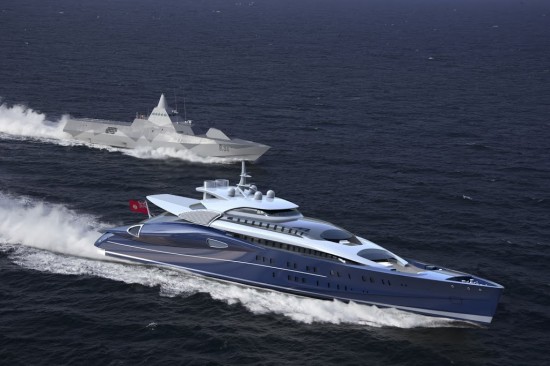High Speed Superyacht will achieve 40+ knots
Blohm and Voss are not normally a yard that issues anything to the media so when a press release from their PR people lands on our desk, we sit up and take notice.
It seems that the German yard is presently developing a series of what they call pre-designed custom yachts, allowing clients to profit from the yard’s experience in super yacht new builds and leading to shorter delivery times as well as reduced building cost. In other words they have cottoned on to what Feadship and Amels are doing and realise that a semi production superyacht is the way many of today’s buyers want to go to own a yacht.
Their first project in this series will be what the yard rather unimaginatively calling the B+V 110 MY/Fast
This 110 metre motor yacht, can trace its ancestry back to the Martin Francis designed 74 m yacht Eco (now renamed Enigma). Back in 1991, she was designed to be the fastest yacht of her size. With three KaMeWa water jets 2 diesel power plants and a gas turbine engine she was capable of 35 knots
This new high-speed yacht has a long stretched profile and a sporty appearance. Below decks close on 110,000 horse power (comparable to 100 Bugatti Veyron’s) is expected achieve speeds of more than 40 knots powered by twin MTU engines driving two steerable Wärtsilä 9000 water jets. Two gas turbines driving two further Wärtsilä 9000 water jet act as sprint engines to boost speed to the maximum speed meaning the yacht can make a non-stop voyage between Monaco and Athens within 25 hours, always assuming the owner can afford the fuel to do so and it is a flat calm day at sea.
With that power packed into one small vessel she may run foul of internationally agreed maximum power ratings that govern the certificates that must be carried by those that man the engine room. Once over 9,000kW certificates issued as yacht engineer’s qualifications cease to be valid
The internal layout and six deck design makes efficient use of space. The Owner’s deck occupies all of the 280 square metres on deck 5. It consists of a large stateroom facing the bow which illuminated using natural sunlight through a skylight; en suite bathrooms as well as an office with a reception and waiting area well located close to the main staircase. A private outdoor deck opens from the state room, forward providing privacy and protection from the elements while sunbathing.
Deck 4 features common and entertaining areas for the Owner and Guests with a lounge that accesses the forward deck where two Jacuzzis have been sited on each side. A separate dining room can be converted into a conference room. The deck also features a library, gym and a second outdoor area aft.
Six guest cabins accommodating 12 guests and the yachts own cinema are well located together one deck below on deck 3. Access to the yacht uses a side gangway leading to the main lobby next to the lift and the main staircase.
The tender garages with side shell doors are located on deck 2 and can accommodate on one side a small light weight seaplane and on the other side a 7m (23 ft) tender as well as various other water toys.
Specifications
LOA: 110.0 metres
Beam: 20.1 metres
Draught: 4.3 metres
Max speed: + 40.0 knots
Cruising speed: 20.0 knots
Range: 970nm @ 40 knots
Range: 3,000nm @ 21 knots
Fuel: 510 tonnes
Fresh water: 70 tonnes
Main Engines: 2 x 9100 kW
Boost Engines: 2 x 32000 kW (gas turbines)
Propulsion 4 x Wärtsilä 9000 steerable water jets
Diesel Generators 2 x 870 kW
Manoeuvring System: 1 x 500 kW bow thruster & 1 stern wing with trim tabs
Passengers:
Total: 14
Owner: 2
Guests: 12
Crew: 27


It can also be devoted to application or operational aspects of Gas turbine‘s for aircraft propulsion and ground power units, or automotive, electric utility, gas pipeline pumping, locomotive, marine, oil field pumping, petrochemical, space power, steel, and similar uses. Papers published anywhere in the world are eligible. Sequential combustion can be visualised as a gas turbine comprising two combustor-turbines in series, where the exhaust gases from the first turbine feed the combustor of the second.
Most commercial jets are powered by turbofan engines, and turbofans are one example of a general class of engines called Gas turbine engines.
In Gas turbine, They can be adapted to use almost any flammable gas or light distillate petroleum products such as gasoline, diesel and kerosene which happened to be available locally.
Gas turbine is must, When you go to an airport and see the commercial jets there, you can’t help but notice the huge engines that power them.
A Gas turbine train is a passenger train that uses one or more gas turbines as its main source of power. Few passenger trains use this system today, although there has been one recent prototype built by Bombardier Transportation.
It may cover topics specifically related to Gas turbine‘s such as high temperature materials or fuel considerations, including erosion and corrosion complications.